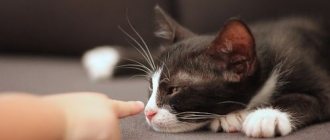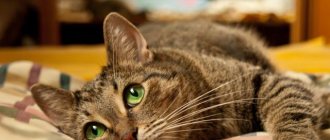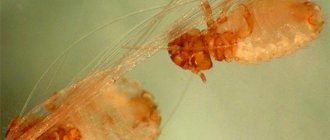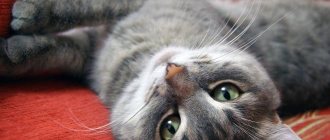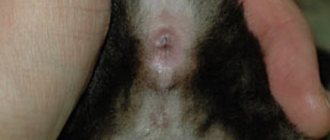Description of the disease
The disease is caused by the Feline calicivirus (FCV). It affects the upper respiratory tract and oral mucosa. Feline calcivirus is registered all over the world, including in Russia. It affects domestic and wild representatives of the cat family. There is no breed selectivity for this infection. Calcivirus is one of the most common causes of upper respiratory tract diseases in cats (along with the herpes virus). Kittens over 2 months old and young kittens up to 2 years old are susceptible. They make up about 90% of the total number of sick animals.
On a note! If the cat is vaccinated against calcivirus infection, then suckling kittens will be protected from infection during the period of feeding with cat milk.
Calcivirus has many variants (more than 40 strains are known). During reproduction, the pathogen exhibits high variability. In this respect, it is similar to the human influenza virus. Strains of the virus differ in symptoms and severity of the disease. Calcivirosis is considered a mild infection. It is dangerous for small kittens, animals with weakened immune systems, old cats or those with chronic diseases. Cats become infected with calcivirus infection throughout the year. The peak incidence occurs in the autumn-winter period.
Caring for a pet during illness
In order for the pet to recover as quickly as possible, it requires care and attention from the owner.
Be sure to change the animal's bedding on a daily basis. The used lounger is washed and steamed. Your pet needs peace and tranquility. Moderate attention.
If your four-legged friend completely refuses water, he is forcibly given water using a syringe without a needle.
To increase appetite, they resort to canned food or preserves. The food is slightly warmed beforehand to enhance the flavor.
The room in which the patient lives is regularly ventilated. Do wet cleaning with disinfectants.
See also: Ringworm in cats: how to notice and treat in time
Routes of infection
Sick cats release the virus into the external environment through discharge from the eyes and nose, and saliva. When you sneeze, the infection spreads through the air several meters around. The virus can easily be brought into the house from the street on clothes, shoes, or hands.
Attention! Domestic cats often become infected through contact with an outdoor kitten brought into the house.
The main routes of infection with calcivirus infection:
- contact with a sick animal;
- airborne;
- through household items - tray, bowls, combs, bedding, cat houses, toys.
Transmission of the pathogen through urine and feces is of less importance. Cats primarily become infected through the mouth or by inhaling viral particles. The virus persists in the environment for about 1–2 weeks, less often up to 1 month. This depends on external conditions - the presence of wet cleaning, indoor air parameters. Humidity and low temperatures increase the viability of the virus. The risk of an infectious outbreak exists in nurseries, with group housing of animals, the appearance of new cats, with poor feeding, and poor indoor air (dusty, dry, hot). Group housing increases the virulence of the virus, and the infection can be more severe.
Pathogen and its features
The causative agent of calicivirosis is RNA-containing viruses belonging to the Caliciviridae family, which includes several species (strains). The pathogen virus has a spherical shape and a relatively small size of up to 40 nm.
The virus is quite resistant, remains viable for a long time and can withstand a week and a half in the external environment. In a dry environment, the virus persists for 2...3 days, and in a humid environment - up to 10 days. Changes in pH (acidity), the action of chloroform and ether do not have a detrimental effect on this virus. However, they are inactivated by solutions of bleach and chloramine.
Symptoms of calcivirosis
Adult cats often become subclinically or asymptomatically ill. An acute course of calcivirosis is noted in kittens. The incubation period lasts from 2 to 17 days. Usually the first symptoms appear 3–5 days after infection. Characteristic:
- bouts of sneezing for 1 – 2 days;
- inflammation of the mucous membrane of the eyes;
- lacrimation;
- runny nose.
On days 3–5 of illness the following are noted:
- increase in body temperature by 1 - 1.5 ° C, in kittens up to 40 - 41 ° C;
- loss of appetite;
- weakness;
- Thick mucus or exudate with pus is released from the eyes and nose;
- the nose is stuffy, the cat breathes through its mouth.
Further symptoms characteristic of calcivirus infection develop.
- Stomatitis and gum inflammation. Red spots appear in the oral cavity on the palate, tongue, and later ulcers form there. They can be on the nose and in the nasal cavity. The cat eats and drinks poorly, makes pushing movements with its tongue, as if it was choking, scratches its nose, coughs, and sneezes. The gums are inflamed, red, swollen, and sometimes a whitish coating is visible on them. There is an unpleasant odor coming from the mouth.
- Profuse drooling.
Body temperature returns to normal after 3–4 days. In kittens and older animals, the infection can develop into viral pneumonia and shortness of breath develops. Inflammation spreads to the trachea, bronchi, and larynx.
Sometimes atypical symptoms appear:
- skin ulcers;
- inflammation of the joints (acute arthritis) - lameness, pain that goes away after a few days;
- ulcers in the stomach and intestines (very rare).
The disease lasts on average 7–10 days , but can last up to 14–21 days . The animal recovers, but continues to release the virus into the external environment. It infects other cats and may have periodic outbreaks of infection. Carrier cats infect their offspring.
Important! After a few months, the intensity of virus release into the external environment decreases. After three months, approximately half of the cats are no longer a source of infection. But some animals remain carriers of the virus for life.
In severe cases, the cat dies from the infection. This mainly occurs due to various complications, the most likely of which are pneumonia and bacterial infection. Death occurs a few days after the onset of the disease. Before death, kittens develop diarrhea, vomiting, and severe weakness. Calcivirosis can become chronic. This is facilitated by the lack of proper treatment and low immunity. The chronic form of calcivirosis manifests itself as stomatitis and gum inflammation. With this form of the disease, the cat requires a course of treatment with immunomodulators every three months. In isolated cases, the disease occurs as a severe systemic infection. It is caused by highly pathogenic strains of calcivirus - vsFCV. The pathogen enters the animal’s body in the usual way, but is not limited to the respiratory tract. The virus infects the inner layer of blood vessels, liver cells, and pancreas. Severe damage to internal organs develops:
- hepatitis;
- pancreatitis;
- nose and intestinal bleeding.
With this form of the disease, swelling of the paws and head, the appearance of ulcers on the animal’s skin, and jaundice are possible. With a systemic infection, more than 60% of sick cats die.
Definition of disease
Rhinotracheitis in cats is a common infectious disease caused by the herpes virus. Kittens aged 1.5 to 6 months are most susceptible to the disease. But adults can also easily become ill upon contact with a source of infection.
With timely recognition of the symptoms of rhinotracheitis in cats and proper treatment, recovery occurs in 80-95% of cases. Vaccination is an effective way to prevent the development of pathology.
The disease occurs in acute and chronic forms, in which a long period of remission alternates with bouts of relapse. After recovery, 80% of pets remain carriers of the virus for life.
Important! Often viral rhinotracheitis in cats is complicated by infectious diseases such as chlamydia, mycoplasmosis or calcivirosis. This increases the mortality rate, especially in kittens and pets with weakened immune systems.
Diagnostics
Diagnosis of calcivirosis is not difficult. The development of acute respiratory disease in cats under 2 years of age, accompanied by characteristic clinical signs, suggests a calcivirus or herpesvirus infection. If there are ulcers in the mouth, then it is a calcivirus. To clarify the diagnosis, laboratory tests are performed.
- A swab of nasal and eye discharge is taken. A PCR study is carried out (determining the virus by genome). It is possible to grow the virus in cell culture, but this method is not widely used. PCR is also used to identify carriers of the virus. If the pathogen is detected in the blood a year after the illness, then the infection has become chronic.
- Blood chemistry. A decrease in hemoglobin levels by 25–30% is detected.
- Serological studies using the method of paired sera.
- If pneumonia is suspected, an x-ray of the lungs is taken.
It is necessary to differentiate calcivirosis from panleukopenia, herpes (feline rhinotracheitis), chlamydia and rabies.
- Herpes is characterized by inflammation of the cornea with ulceration and cough. There is no stomatitis, mouth ulcers, drooling, or lameness.
- With chlamydia, a spasm of the eyelid and the release of the third eyelid into gas are noted. There is no drooling or mouth ulcers.
- With rabies, there are signs of brain damage (changes in behavior, seizures, convulsions). No mouth ulcers, runny nose.
- Panleukopenia (cat distemper) occurs with abdominal pain, vomiting, and leukocytes in the blood are greatly reduced.
Diagnosis by a veterinarian
If the owner notices the warning signs described above, then it is time for an emergency visit to the veterinary clinic. At a doctor's appointment, you need to answer questions about the presence or absence of a pathological desire in your pet to inhale chemicals and washing powder. It is necessary to find out whether he chewed toxic house plants, for example, Kalanchoe, aloe. Explain what was included in the last feeding and what the pet has been doing over the past 24 hours.
The veterinarian may also ask leading questions that may not seem entirely meaningful to the patient’s owner. Most likely, the doctor will ask whether there is air conditioning in the house, when and with what the pet was last bathed. Thanks to questioning, a general picture of the disease emerges, which helps to make the correct diagnosis.
The veterinarian prescribes a PCR test to determine the presence of the virus in the animal’s DNA. Repeated studies are often performed, especially if the results are negative but the symptoms do not subside. If it is not possible to conduct such an analysis, the disease is determined by the clinical picture.
Treatment
If there are no complications, then the cat can be treated at home. When kept in groups, sick individuals are isolated. Separate inventory is allocated; service personnel change their overalls, wash and disinfect their hands. Disinfect the premises where the sick animal was located. Therapy is carried out in several directions.
On the first day, while the pathogen is circulating in the blood, it is possible to administer the specific serum Vitafel. The drug contains gamma globulins for three cat infections: calcivirus, herpesvirus and panleukopenia. In severe cases of the disease, the administration of Vitafel is repeated every other day. If the serum was not applied on the first day of the disease, then treatment with it at a later date is ineffective.
Attention! All medications are prescribed by a veterinarian after examining the cat. Self-medication can be dangerous.
To reduce the likelihood of an allergy to serum, antihistamines are prescribed:
- Suprastin;
- Diphenhydramine;
- Tavegil.
If a bacterial infection develops, antibiotics are prescribed:
- Amoxiclav;
- Ceftriaxone or other cyclosporine drugs.
Immunomodulators stimulate the production of immune response factors:
- Fosprenil;
- Roncoleukin;
- Ribotan;
- Reaferon;
- Immunofan;
- Katozal;
- Cycloferon;
- Maxidin.
For joint damage and signs of lameness, injections of anti-inflammatory drugs are given:
- Ketofen;
- Rimadyl;
- Stop arthritis.
The oral cavity is irrigated with disinfectant solutions:
- Furacillin;
- Chlorhexidine.
Ulcers in the mouth and nose are lubricated with Lugol's solution with glycerin or Vinilin.
For general strengthening of the body, complex vitamins are prescribed in injections, since the cat eats and drinks poorly. Some preparations contain amino acids in addition to vitamins:
- Gamavit;
- Multivit;
- Ultravit;
- Aminovit.
In case of dehydration and severe intoxication, detoxification solutions are administered intravenously:
- Reopoliglyukin;
- Sorbilact;
- Ringer's solution;
- glucose solution 5%;
- Ringer-Locke solution;
- Hartmann's solution.
Usually, with this condition, the cat is hospitalized in a hospital.
- Remove exudate from the eyes and nose with a damp cotton pad. For severe nasal congestion, it is recommended to instill 0.025% Afrin (children's nasal drops) one drop in one nostril, the next day in the other, for 5 to 7 days.
- Purulent conjunctivitis is treated with eye drops (Maksidin). They are instilled three times a day after cleaning the eyes. Instead of drops, you can use tetracycline eye ointment; it is placed behind the lower eyelid twice a day.
During illness, the cat is switched to wet food - canned food, preserves. The food is slightly heated so that the animal smells better. If the pet refuses water, then they practice forced watering from a syringe. The room must be provided with moist, cool air and regularly ventilated. Treatment of calcivirosis in cats can last up to 2 months, depending on the severity of the disease and complications.
Treatment of calcivirosis
Effective treatment of calcivirosis begins with a correct diagnosis. Due to the difficulty of diagnosing the disease, it is recommended to contact a veterinary clinic at the first signs of your pet’s discomfort.
A caring breeder knows that the sooner you provide correct assistance to your pet, the lower the risk of complications.
As a rule, therapy begins with the use of broad-spectrum antibiotics. The next step is taken towards raising immunity. For this purpose, stimulants and vitamins are used.
Lack of appetite and high temperature lead to exhaustion and dehydration. Therefore, to ensure the vital functions of the body of a sick animal, a nutrient solution is administered.
Calcivirosis is accompanied by thick discharge from the eyes and nose. Cleansing is done with saline solution.
Therapeutic and preventive measures of the oral cavity are used. With proper treatment, noticeable improvements occur already on the second or third day. The main thing is not to delude yourself! The virus has not yet been defeated. It is required to continue the procedures for the period indicated by the veterinarian. Typically, active therapy lasts from five to seven days.
Interruption of treatment risks relapse and severe complications.
Possible complications
In most cases, calcivirosis is complicated by a bacterial infection. The probability of death increases to 60%. Other complications of feline calcivirus infection:
- pneumonia;
- dehydration;
- tooth loss due to gum inflammation;
- renal failure in chronic course.
Mechanism of disease development
Once in the cat's body, the causative agent of rhinotracheitis penetrates the mucous membranes of the oral cavity, tonsils, upper respiratory tract and conjunctiva, where it begins to multiply intensively. This gradually leads to necrosis and inflammation of epithelial tissues.
The feline herpes virus also has an affinity for nerve tissues. After penetration into neurons, the pathogen remains in them forever. This explains the formation of lifelong virus carriers in recovered animals.
Important! Cats with a strong immune system do not show clinical symptoms of rhinotracheitis. But at the same time, they become virus carriers and are able to infect other pets.
Prevention
The only reliable way to prevent calcivirus infection in cats is vaccination. Veterinarians include vaccination against this disease in the standard vaccination regimen. The vaccine does not completely protect a cat from infection with calcivirus, since there are many varieties of it. But the presence of immunity makes it easier to endure the infection and avoid complications. The likelihood of infection is also reduced. Vaccinations begin for kittens from 8 to 12 weeks of age. The vaccine is administered two or three times. Afterwards, revaccinations are done every 1-3 years. Vaccines contain different numbers of strains. There is no biological product that can protect cats from all types of calcivirus. Complex vaccines are used for vaccination.
- Nobivac Ducat. Intervet , Holland. Live dry vaccine against viral rhinotracheitis and feline calicivirus. Initially, they are vaccinated twice with an interval of 3–4 weeks. Immunity is developed 10 days after the second administration, its duration is 12 months. Nobivac Ducat can be used from 6 weeks of age.
- Nobivac Tricat . Vaccine against calicivirus, viral rhinotracheitis and feline panleukopenia live dry. The characteristics of the drug are similar to the previous vaccine, but it can only be used from 8 weeks of age.
- Multifel-4. NPO "Narvak" , Russia. Inactivated (killed) vaccine against panleukopenia, rhinotracheitis, calicivirus and feline chlamydia. Kittens are vaccinated at the age of 8 – 12 weeks. The vaccine is administered twice with an interval of 21–28 days. Revaccinate once at the age of 10-12 months. Then the vaccination is repeated once a year. Immunity is developed 14 days after the second injection of the vaccine, the duration of protection is 12 months.
- Vaccines of the "Purevax" . Merial , France. Trivalent "Purevax RCP" and tetravalent "Purevax RCPCh" (against panleukopenia, infectious rhinotracheitis, calicivirus infection and feline chlamydia). Contains an inactivated calcivirus component. Immunity to calcivirus infection is developed 14 days after the second injection of the vaccine, for a period of one year.
Only healthy animals can be vaccinated. Before vaccination, deworming is carried out. Before mating, it is recommended to vaccinate the cat 3–4 weeks in advance to ensure a high level of maternal antibodies in future offspring. Pregnant cats cannot be vaccinated. In addition to vaccination, they follow the general rules for the prevention of infectious diseases.
- Complete feeding.
- Housing hygiene: regular wet cleaning (in case of group housing - regular disinfection), compliance with zoohygienic air parameters (ventilation, temperature, humidity).
- In group housing, newly arrived animals are kept separately for 10-14 days (quarantine).
- The cat owner is not recommended to visit homes where there are sick pets. If this is not possible, then after returning they change clothes, wash their hands thoroughly with soap, and do not allow the cat to come into contact with outdoor clothing and shoes.
Calcivirus infection in most cases ends safely. The disease is more difficult for small kittens and weakened animals. In any case, at the first signs of infection - sneezing, runny nose, drooling, refusal to feed - the cat should be shown to a veterinarian. He will prescribe treatment, which is usually carried out at home. To protect your cat from calcivirus infection, it is recommended to get vaccinations on time.
Prevention of calcivirosis in cats
It is known that there is no 100% protection for a cat from infection with calicivirus. But this does not mean that you need to sit and hope for a miracle.
There are certain measures that breeders can take to minimize the risk of contracting the virus and also alleviate possible complications.
The main recommendations are as follows:
- Regular ventilation of the premises (house, apartment);
- Balanced diet;
- Minimizing contact with stray animals;
- Regular cleaning and disinfection of water and food bowls;
- Regular and timely cleaning, as well as disinfection of the cat litter box. The use of rubber gloves is mandatory;
- Vaccination.
Vaccinations are perhaps one of the most important measures against calcivirus. It is vaccination that can minimize the risk of complications. In addition, a vaccinated pet is much easier to tolerate the disease.
It is important to know that you should consult your veterinarian before vaccination. The animal must be absolutely healthy. The vaccine places a significant strain on the immune system. If it is weakened, then the injection will do more harm than good.
Ten days before the event, the pet is dewormed.
Pregnant cats are not vaccinated.
The first vaccinations are given to kittens at eight to twelve weeks of age. The further vaccination schedule is coordinated with a veterinarian, who will take into account the characteristics of the breed and the pet’s lifestyle.
Symptoms of the disease
Calcivirus in cats is characterized by the following symptoms:
— For the first three days, body temperature can rise to 41 degrees, and then normalizes.
- Watery eyes, runny nose. At the beginning of the disease, there is increased salivation, and the drool is transparent, but later it becomes cloudy, sometimes with blood in it.
- When the respiratory tract is affected, coughing and sneezing appear.
— Ulcers appear throughout the mouth, on and inside the nose, which makes the animal eat poorly. The gums are inflamed and have a whitish coating.
— The cat becomes “sad”, lethargic, and almost does not respond to its name.
— When the virus actively multiplies in the brain, aggression, convulsions, and loss of coordination are observed.
- Vomiting, diarrhea or constipation, lack of appetite.
— The disease is often accompanied by conjunctivitis.
Read more: Symptoms and treatment of conjunctivitis in cats
Murkoshi specialists would like to draw your attention to the fact that cats that have been vaccinated are asymptomatic or have minor clinical manifestations.
The fourth sign is breathing problems
Since calcivirus infection primarily affects the respiratory tract, symptoms of respiratory failure occur frequently. The incubation period of the pathogen is from several days to 1 week. Calcivirosis, which occurs in a mild form in a pet with good immune protection, goes away on its own after 21 days, ending with complete recovery. But during this period it is very important to monitor the animal’s health. In addition to the fact that the cat is a carrier of the virus throughout the entire period of the disease, the risk of developing problems in the respiratory tract is very high.
A sign of calcivirosis is the appearance of a severe cough and shortness of breath in a pet, especially in old age. Ulcers appear on the mucous membranes of the oral cavity and heal on their own after 2 weeks. But the danger lies in damage to the cellular structures of the tonsils. In turn, this can lead to degenerative changes and tissue necrosis. The gates for pathogenic bacterial microflora will always be open and the animal will more often be susceptible to the development of various inflammations in the respiratory system.
The second sign is ulcerative lesions in the mouth
The second sign of the development of calcivirus infection in a cat is the development of ulcers on the oral mucosa. Calcivirosis is characterized not just by ulcers, but also by the appearance of a strong, unpleasant odor from the mouth. Ulcers occur not only in the oral cavity, but also affect the area of the nasal planum. The lesions are small in size, first fill with exudate, then burst and constantly bleed. Ulcers cause your pet severe discomfort and pain, especially when eating. This is where the next symptom comes from – refusal to feed.
Consequence of the disease
global $ads_google; //data-ad-slot=”2475549904″ $ads_google = empty($ads_google) ? false : true; ?> if ($ads_google == false) {?> $ads_google = true; ?> } ?>
At an early age, the risk of death of an animal not vaccinated against calcivirus is high - for every 100 cases of infection, only 20 have a favorable outcome. The remaining 80 die. Cats as adults have a much better chance of recovery: out of 100 cases, with timely treatment, 70% survive. Old cats do not have such a strong immune system, so their chances of survival are 50/50. But in any case, there is always a chance that the disease will become chronic, and the recovered cat will become a carrier of the virus.
Treatment regimen for the disease - veterinary care at home
If a cat infected with the simplest calcivirus does not have an increase in body temperature and the possibility of unilateral/bilateral pneumonia is excluded, then treatment takes place at home, without forced hospitalization. The treatment complex includes the following scheme of measures:
- Taking antibiotics characterized by a wide range of effects on microorganisms. This could be Flemoxin, which is taken for 7.5-10 days. The daily dose for an adult cat is 12.4-21.8 mg/kg. The dose is divided into morning and evening doses.
- Stimulation of immune defense by taking specialized drugs - Immunofan or Fosprenil.
- Sanitation of the oral cavity through the use of antiseptic solutions that are applied to a cotton pad. With its help, the hard palate and tongue of the animal are wiped at least 3 times a day.
- Cleaning the nose with special sprays, as well as cleaning the eyes from purulent deposits and serous discharge.
- Lighter nutrition with a decrease in daily caloric intake. It is best to feed your cat broths with minimal addition of meat fiber.
Specialists at the NEOTLOZHKA veterinary clinic recommend limiting the animal’s daily activity during treatment. To eliminate the possibility of a recurrence of the disease, your pet should receive all vaccinations , taking into account the recommended vaccination schedule.
What is feline calicivirus
The FCV virus is the cause of most respiratory diseases in cats. The virus is stable and quickly adapts to environmental conditions, which complicates the development of a sustainable vaccine.
Calcivirus is quite common among cats. Approximately 10% of pets have calcivirus or are carriers of it. In shelters and nurseries this figure can reach 25-40%. The body of a sick animal releases the virus along with saliva, urine and feces. It is also transmitted by airborne droplets.
Risk group
Calcivirosis is very dangerous only for kittens, unvaccinated adult cats and weakened elderly animals, since the body's resistance to this category of animals is significantly reduced.
The mortality rate from calcivirosis in kittens and older animals ranges from 15 to 30%.
The virus does not pose a danger to humans and other types of domestic animals.
Important!
Start antiviral therapy in a timely manner - with proper treatment, the animal will recover.
Diagnosis of calcivirosis
A visual examination is not enough to make a final diagnosis, since other respiratory infections may also fit the clinical signs listed above. To exclude diseases such as rhinotracheitis and chlamydia, it is necessary to submit biological fluids (blood, saliva, nasal discharge) for analysis to the laboratory. The doctor also needs to find out the conditions against which the disease developed, that is, collect an anamnesis. Only after going through all stages of diagnosis can a veterinarian make the correct diagnosis and prescribe effective treatment.
.
Treatment and prognosis
Unfortunately, there are no universal drugs against feline calcivirosis yet. Typically, treatment of calicivirus infection involves the use of agents with a different spectrum of action:
- antibiotics (Amoxicillin, Tylosini others);
- eye drops (Bars, Tsiprovet);
- antiviral drugs (Maksidin);
- intravenous injections against dehydration (Ringer-Locke solution or 5% glucose);
- nasal drops (Naphthyzin);
- disinfectant solutions for the oral cavity (Chlorhexidine, Furacilin);
- antiseptic preparations for oral care and treatment of ulcers (Lugol, Iodinol);
- multivitamins.
The use of all of the above remedies without a doctor’s prescription is strictly prohibited, even if there are signs of illness. The cat can be treated only after the diagnosis is confirmed and the doctor prescribes a dosage regimen and calculates the dosage of the medications.
Getting rid of calicivirus from your pet will happen faster if its conditions improve:
- Feeding liquid, slightly warmed food.
- Humid and cool air in the apartment, periodic ventilation.
- Regular disinfection of the cat bed and grooming items.
- Drink plenty of warm drinks.
- Daily hygiene procedures for eyes, nose and mouth.
If you consult a doctor in a timely manner and follow all his recommendations, calicivirus can be cured. If the disease was diagnosed at an early stage, the veterinarian will allow treatment at home. In this case, recovery will occur in approximately 7-10 days.
If there are complications, therapy will have to be carried out in a hospital setting, and treatment may take several months.
The development of complications with calicivirus in cats in most cases is a consequence of untimely or incorrect treatment, as well as non-compliance with doctor’s recommendations.
The most common complications:
- dehydration;
- pneumonia;
- brain damage;
- bronchitis;
- excessive weight loss;
- stillbirth of kittens;
- tooth loss.
When the first symptoms of the disease are detected in young animals, special attention should be paid. Signs of calicivirus in kittens appear in the same way as in adults. However, in children the disease is much more complicated.
For example, a kitten 1-4 months old, if left untreated, dies 2-3 days after the first symptoms appear.
A kitten's immunity is formed until about 12 months, so its body cannot cope with the disease.
